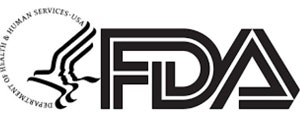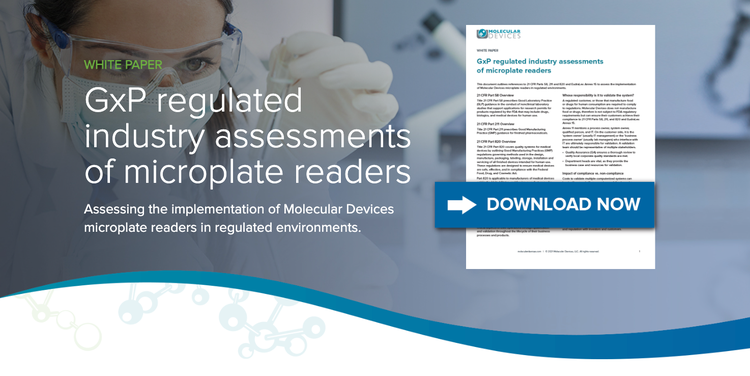
Microplate Reader의 GxP 규제 업계 평가
This document outlines references to 21 CFR Parts 58, 211 and 820 and EudraLex Annex 15 to assess the implementation of Molecular Devices microplate readers in regulated environments.
21 CFR Part 58 Overview
Title 21 CFR Part 58 prescribes Good Laboratory Practice (GLP) guidance in the conduct of nonclinical laboratory studies that support applications for research permits for products regulated by the FDA that may include drugs, biologics, and medical devices for human use.
21 CFR Part 211 Overview
Title 21 CFR Part 211 prescribes Good Manufacturing Practice (GMP) guidance for finished pharmaceuticals.
21 CFR Part 820 Overview
Title 21 CFR Part 820 covers quality systems for medical devices by outlining Good Manufacturing Practices (GMP) regulations governing methods used in the design, manufacture, packaging, labeling, storage, installation and servicing of all finished devices intended for human use. These regulations are designed to ensure medical devices are safe, effective, and in compliance with the Federal Food, Drug, and Cosmetic Act.
Part 820 is applicable to manufacturers of medical devices sold in the United States, and foreign manufacturers who import their products for distribution in the United States.
Molecular Devices products maintain the label, “For Research Use Only”, as they are not medical devices intended to diagnose a disease or other condition.
EU GMP Annex 15 Overview
Annex 15 describes the principles of qualification and validation applicable to equipment, facilities, utilities, and processes used for the manufacture of medicinal products. It is a GMP requirement for manufacturers to control the critical aspects of their operations through qualification and validation throughout the lifecycle of their business processes and products.
Whose responsibility is it to validate the system?
A regulated customer, or those that manufacture food or drugs for human consumption are required to comply to regulations. Molecular Devices does not manufacture food or drugs, therefore is not subject to FDA regulatory requirements but can ensure their customers achieve their compliance to 21 CFR Parts 58, 211, and 820 and EudraLex Annex 15.
Annex 11 mentions a process owner, system owner, qualified person, and IT. On the customer side, it is the ‘system owner’ (usually IT management) or the ‘business process owner’ (usually lab managers) who interface with IT are ultimately responsible for validation. A validation team should be representative of multiple stakeholders.
- Quality Assurance (QA) ensures a thorough review to verify local corporate quality standards are met.
- Department heads are vital, as they provide the business case and resources for validation.
Impact of compliance vs. non-compliance
Costs to validate multiple computerized systems can be significant and efforts must be carefully planned to identify resources and procurement and project expenses. Some organizations may enlist third parties to design and execute computerized system validation, but the responsibility for the validation effort and maintaining a compliant validated system cannot be delegated and remains with the regulated customer per regulations in 21 CFR Parts 58.63 and 820.70 and Annex 15.
Public record of judgements against pharmaceutical or independent/contract labs show that the cost of non-compliance is significant (can be in the millions of dollars) for lost productivity and revenue, costs for rework, and reputation with investors and customers.

The Code of Federal Regulations (CFR) is a codification of the general and permanent rules published in the Federal Register by the departments and agencies of the Federal Government.
It is divided into 50 titles that represent broad areas subject to Federal regulation.
Title 21 of the CFR is reserved for rules regulated by the
Food and Drug Administration (Dept. of Health and Human Services), the Drug Enforcement Administration (Dept. of Justice) and the Office of National Drug Control Policy.
- Part 58 – Good Laboratory Practices for Non-Clinical Laboratory Studies
- Part 211 – Current Good Manufacturing Practice for Finished Pharmaceuticals
- Part 820 – Quality System Regulation

Volume 4 of "The rules governing medicinal products in the European Union" contains guidance for the interpretation of the principles and guidelines of good manufacturing practices for medicinal products for human and veterinary use.
The GMP Guide is presented in three parts and supplemented with annexes that represent broad areas subject to Federal regulation.
- Part 1 – Basic Requirements for Medicinal Products
- Chapter 3 – Premise and Equipment
- Chapter 4 – Documentation
- Annex 15 – Qualification and validation
Table 1: Assessment of 21 CFR Part 58 Compliance for Plate Reader Validation & Maintenance.
Reference to 21 CFR Part 58
Subpart D – Equipment
Molecular Devices
Products/Services
§58.61 – Equipment design
Equipment used in the generation, measurement, or assessment of data and equipment used for facility environmental control shall be of appropriate design and adequate capacity to function according to the protocol and shall be suitably located for operation, inspection, cleaning, and maintenance.
§58.63 – Maintenance and calibration of equipment
(a) Equipment shall be adequately inspected, cleaned, and maintained. Equipment used for the generation, measurement, or assessment of data shall be adequately tested, calibrated and/or standardized.
IQ/OQ services ensure computerized systems (plate reader and software entity) are performing within specification.
SOPs for plate reader maintenance and use of SpectraTest® Validation Plates are available.
Table 2: Assessment of 21 CFR Part 211 Compliance for Plate Reader Validation & Maintenance.
Molecular Devices
Products/Services
§211.160 – General requirements
(b) Laboratory controls shall include the establishment of scientifically sound and appropriate specifications, standards, sampling plans, and test procedures designed to assure that components, drug product containers, closures, in-process materials, labeling, and drug products conform to appropriate standards of identity, strength, quality, and purity. Laboratory controls shall include:
(4) The calibration of instruments, apparatus, gauges, and recording devices at suitable intervals in accordance with an established written program containing specific directions, schedules, limits for accuracy and precision, and provisions for remedial action in the event accuracy and/or precision limits are not met. Instruments, apparatus, gauges, and recording devices not meeting established specifications shall not be used.
§211.194 – Laboratory Records
(d) Complete records shall be maintained of the periodic calibration of laboratory instruments, apparatus, gauges, and recording devices required by §211.160(b)(4).
Table 3: Assessment of 21 CFR Part 820 Compliance for Plate Reader Validation & Maintenance.
Reference to 21 CFR Part 820
Subpart G – Production and Process Controls
Molecular Devices
Products/Services
§820.70 – Production and Process Controls
(g) Equipment. Each manufacturer shall ensure that all equipment used in the manufacturing process meets specified requirements and is appropriately designed, constructed, placed, and installed to facilitate maintenance, adjustment, cleaning, and use.
§820.72 – Inspection, measuring, and test equipment
(a) Control of inspection, measuring, and test equipment—Each manufacturer shall ensure that all inspection, measuring, and test equipment, including mechanical, automated, or electronic inspection and test equipment, is suitable for its intended purposes and is capable of producing valid results. Each manufacturer shall establish and maintain procedures to ensure that equipment is routinely calibrated, inspected, checked, and maintained.
IQ/OQ and/or PM/OQ services and SpectraTest Validation Plates ensure instruments are performing within specification traceable to NIST and NMI standards.
A completed report is provided to the customer at the completion of the IQ/OQ or PM/OQ service.
Table 4: Assessment of EudraLex Volume 4 (Part 1) Compliance for Plate Reader Validation & Maintenance.
Reference to EudraLex Volume 4
Part 1 – Basic Requirements for Medicinal Products
Molecular Devices
Products/Services
Chapter 3 – Premises and Equipment
3.41 Measuring, weighing, recording, and control equipment should be calibrated and checked at defined intervals by appropriate methods. Adequate records of such tests should be maintained.
Chapter 4 – Documentation
4.29 There should be written policies, procedures, protocols, reports and the associated records of actions taken or conclusions reached, where appropriate, for the following examples:
- Validation and qualification of processes, equipment and systems
- Equipment assembly and calibration
Table 5: Assessment of EudraLex Volume 4 (Annex 15) Compliance for Plate Reader Validation & Maintenance.
Reference to EudraLex Volume 4
Annex 15: Qualification and Validation
Molecular Devices
Products/Services
Section 2 – Documentation
2.5 Qualification documents may be combined together, where appropriate, e.g. installation qualification (IQ) and operational qualification (OQ).
Section 3 – Qualification Stages for Equipment,
Facilities, utilities and Systems
3.1 Qualification activities should consider all stages from initial development of the user requirements specification through to the end of use of the equipment, facility, utility or system. The main stages and some suggested criteria (although this depends on individual project circumstances and may be different) which could be included in each stage are indicated below:
Factory acceptance testing (FAT) /Site acceptance testing (SAT)
3.4. Equipment, especially if incorporating novel or complex technology, may be evaluated, if applicable, at the vendor prior to delivery.
설치 적격성평가(IQ)
3.8. IQ should be performed on equipment, facilities, utilities, or systems.
3.9. I Q should include, but is not limited to the following:
i. Verification of the correct installation of components, instrumentation, equipment
ii. Verification of the correct installation against pre-defined criteria iii. Collection and collation of supplier operating and working instructions and maintenance requirements iv. Calibration of instrumentation
운영 적격성평가(OQ)
3.10. O Q normally follows IQ but depending on the complexity of the equipment, it may be performed as a combined Installation/Operation Qualification (IOQ).
3.11. OQ should include but is not limited to the following:
i. Tests that have been developed from the knowledge of processes, systems and equipment to ensure the system is operating as designed
ii. Tests to confirm upper and lower operating limits, and/or “worst case” conditions
Performance qualification (PQ)
3.13. PQ should normally follow the successful completion of IQ and OQ. However, it may in some cases be appropriate to perform it in conjunction with OQ or Process Validation.
3.14. PQ should include, but is not limited to the following:
i. Tests, using production materials, qualified substitutes or simulated product proven to have equivalent behavior under normal operating conditions with worst case batch sizes. The frequency of sampling used to confirm process control should be justified.
ii. Tests should cover the operating range of the intended process, unless documented evidence from the development phases confirming the operational ranges is available.
Section 4 – Re-Qualification
4.1 E quipment, facilities, utilities and systems should be evaluated at an appropriate frequency to confirm that they remain in a state of control.
검증된 GxP 솔루션으로 데이터 무결성 및 Compliance 보장
Our mission at Molecular Devices is to assist our customers in achieving compliance in GLP (good laboratory practices) and GMP (good manufacturing practice) regulated labs. We have developed proven GxP compliance solutions with microplate detection systems and software. Combined with installation and validation services along with IQ/OQ support, our solutions assure data integrity.
